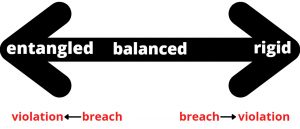1.5 Professional Boundaries
“Bring your best self! Show up, be prepared, maintain healthy boundaries, and ask for support when you need it. Be curious and know that you are at the beginning stage of learning what is required of you in this field” (Donna Mansfield, Sault College CYC Program Faculty and College Placement Supervisor)
A key component in professional Child and Youth Care practice is boundaries, as boundaries establish the basis for the therapeutic relationship. According to the Oxford Learner’s Dictionary (n.d.), a boundary is “the farthest limit of something; the limit of what is possible or acceptable” (para. 1). A therapeutic relationship is a planned, goal-directed connection between a CYC and a child, youth and/or family for the purpose of providing care in order to meet the therapeutic needs of the client (Fox, 2019).
Boundaries can be professional or personal. Professional boundaries are usually covered by professional standards like the Code of Ethics, while personal boundaries may be less explicit—they may include physical, emotional, and mental limitations, which CYCs adopt to protect themselves from becoming overly-invested in their clients’ lives.
Learn More
“Professional Boundaries in Health-Care Relationships” (link opens in new page) is an excellent online article about boundaries and boundary violations from the College of Psychologists of Ontario (n.d.). Although this article was written with psychologists in mind, much of it directly applies to any client-carer relationship.
When you look at the definition of boundaries as it relates to CYC practice, you can imagine that there wouldn’t necessarily be rigid, set boundaries that can be set for every situation. As CYC practice is relationally based, these boundaries are imperative, yet quite difficult, to define, as the role of a CYC varies immensely depending on many factors. Conrad et al. emphasize the challenge of finding balance in CYC work with regards to boundaries:
Child and youth care (CYC) practitioners strive to find a balance between (a) caring about young people they work with in over-involved, dependence-creating ways, as they are genuinely moved by their life stories and current needs, and (b) not caring enough as they defend themselves against burn-out [sic], secondary traumatic stress, and compassion fatigue. (as cited in Davidson, 2004, para. 1)
Several factors influence what professional boundaries might look like, such as “the needs of the young person, the role of the professional, the quality and depth of the relationship with the young person, the mandate of the agency, the physical construction of the setting, the size of the community and the cultural context” (Davidson, 2004, para. 2). All these factors can make simple, pre-prescribed answers difficult to apply to all circumstances, hence the importance of supervision and self-reflection/awareness.
The Professional Relationship Boundaries Continuum (Davidson, 2004) below refers to “professionals’ attitudes toward emotional connections with, and involvement in[,] the lives of young people and their families in light of the position of trust and power that the professionals are privileged to hold” (para. 3). This framework is not perfect, but it can be a starting place when having discussions regarding professional boundaries in relational CYC practice.

This continuum illustrates the range of professional boundaries, with one extreme including entangled boundaries and the other extreme being rigid boundaries. A balanced approach is the most desirable option. In Davidson’s (2004) words:
- Entangled: When CYCs become too over-involved in clients’ lives, they invest more of their time, emotional energy or favour in these relationships than in others, and they meet their own emotional, social, or physical needs through the relationship at the client’s expense.
- Rigid: When CYCs storm ahead with their own agenda inflexibly, condescendingly, and/or without attending to the unique and multi-faceted needs of the client, they lack authenticity and sensitivity and exploit the client’s vulnerabilities, abusing their position of power as they accentuate the power difference between them.
- Balanced: A balanced CYC has an authentic and caring manner while maintaining clear boundaries. These professionals remain aware of their position of power and take care neither to exploit a client’s vulnerabilities nor to infringe upon their rights. They actively use professional judgement, consistently apply self-reflection skills, and are intentionally accountable to other professionals. Professionals with balanced boundaries determine and attend to clients’ unique and complex needs while maintaining the key distinctions of their professional role in the relationship. (The Professional Relationship Boundaries Continuum section, para. 3)
The goal for professional CYCs is to find a way to ensure that professional relationships fall in the mid-range of this continuum so that relationships are balanced and no harm is done to the child, youth and/or family the CYC is working with. As you become more involved in the CYC program and placements, you will begin to recognize where you fall regarding boundaries with the children, youth, and families you work with. Each situation you find yourself in will involve a reflection on personal and professional boundaries to ensure you are providing the best care possible.
Being able to gradually develop boundary awareness, “the ability to be reflective and objectively evaluative about the need for closeness or distance in a relationship” (Mann-Feder, 2021, p. 140), is imperative. As this skill is developed, it allows for the CYC to better reflect on relational dynamics and set appropriate boundaries in each unique situation.
Media Attributions
- Professional Relationship Boundaries Continuum © Melanie Jones is licensed under a CC BY-SA (Attribution ShareAlike) license

